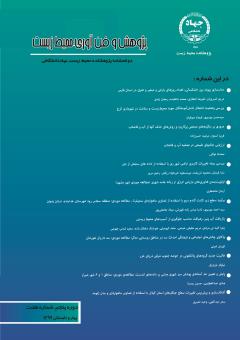غالبیت جدید گروه های پلانکتونی در حوضه جنوب شرقی دریای خزر
محورهای موضوعی : محیط زیست جانوری
1 - دانشگاه علوم کشاورزی و منابع طبیعی گرگان
کلید واژه: جنوب شرقی دریای خزر, فیتوپلانکتونها, زئوپلانکتونها,
چکیده مقاله :
مطالعه مستمر اکولوژیک دریای خزر، به خصوص پراکنش، شناسایی گونه ها و نوسانات منطقه ای، قبل از هر مطالعه ضروری به نظر می رسد. بر این اساس در پژوهش حاضر نوع غالبیت گروه های پلانکتونی در حوزه جنوب شرقی دریای خزر مورد مطالعه قرار گرفت. برای این منظور نمونه برداری از گروه های پلانکتونی در شهریور سال 1394، 1 بار و با 3 تکرار صورت گرفت. نتایج حاصل از بررسی فیتوپلانکتون ها حاکی از وجود 4 راسته، 4 خانواده و 4 جنس در مناطق مورد بررسی بوده است، که به ترتیب شاخه های Euglenophyta (جنسEuglena، تراکم 9/99 درصد)، Dinoflagellata (جنس Prorocentrum، تراکم 5/99 درصد) و Bacillariophyta (گروه Diatomatae، تراکم 100 درصد) اصلی ترین فلور فیتوپلانکتونی اکوسیستم را تشکیل داده اند. جنس اوگلنا شاخص آب های هایپرتروف بوده و اولین بار است که در حوضه های مورد مطالعه به صورت غالب دیده شده است. نتایج حاصل از بررسی زئوپلانکتون ها نیز حاکی از نابودی این گروه پلانکتونی است (تنها 1 عدد زئوپلانکتون گونه Keratella cochlearis از دسته Rotifera مشاهده شد) که اصلی ترین دلیل آن سم تولید شده از اوگلناها و نیز شرایط بی هوازی مستقر در اکوسیستم در نتیجه انتشار سم مذکور بوده است. به طور کل نتایج، حاکی از وضعیت کیفی وخیم مناطق مورد بررسی، از بین رفتن مقادیر بالایی از فون و فلور زیستی و غالبیت گروه های پلانکتونی سمی و نامناسب در اکوسیستم می باشد.
An ongoing ecological study of the Caspian Sea, in a particular distribution, identifying the species composition and regional variations, seems to be necessary before any study. According to this, in the present study, the type of dominance of planktonic groups in southeastern basin of the Caspian Sea (Golestan Province) was studied. For this purpose, sampling of planktonic groups was done once in September 2015 with 3 repetitions. The results of phytoplankton study showed that there are 4 orders, 4 families and 4 genera in the study areas, which constitute Euglenophyta (Euglena sp. 99.9% density), Dinoflagellata (Procentrum sp. 99.5% density) and Bacillariophyta (Diatum group. 100% density), the main phytoplanktons flora of the ecosystem, respectively. The Genus Euglena is the index of hypertrophic waters and is the first time that has been seen predominantly in the studied basins. The results of zooplankton study also indicate the destruction of this planktonic group (only 1 zooplankton of the species Keratella cochlearis from the genus Rotifera was observed), which is mainly due to the toxin produced by Euglena and the anaerobic conditions in the ecosystem. In general, the results indicate a critical quality status of the studied areas, the loss of high amounts of living fauna and flora and the dominance of toxic and inappropriate planktonic groups in the ecosystem.
Abrikosov, G.G., Kosova, A.A. 1963. On finding of the tropical freshwater bryozoans Lophopodella Carteri (Bryozoa, Phylactolaemata). Zoologicheskii Zhurnal, 42: 1724–1726.
APHA, S., 2005. Standard Methods. American Public Health Association .Washington, DC 2005, USA, PP: 346.
Dhrubajyoti Bordoloi and P. P. Baruah. 2014. Water quality assessment using phytoplankton in a historical pond of Upper Assam. Journal of algal biomass utilization. 5(2): 1-7.
Fazli, H. and Ganjian, A. 2009. Analysis of Hydrology and Hydrobiology data of Caspian Sea during 1991- 2006). Iranian Fisheries Research Institute. (In Persian).
Fogg, G. E. 1975. Algal culture and phytoplankton ecology. Wisconsin University Press, London.269p.
Golaghayi, M., Tahami, F.S., Makhloogh, A., Ganjian, A., Keihansani, A., Doostdar, M., Eslami, F., Nasrollah tabar, A., Khodaparast, N., Mokrami, A. and Poormand, T. 2012. The distribution of phytoplankton in the southern Caspian Sea during in 1999. Caspian Sea Ecology Research Institute. 130 p. (In Persian).
Heidari, M., Seifabadi, S.J. and Khanipoor, A.A. 2011. Determination of zooplankton biological indices at different depths and overnight hours in the coastal waters of Bandar-e-Anzali. Journal of Biology. 24(4): 623- 631. (In Persian).
Herman, S. S., Mihursky, J. A. and McErlean, A. J. 1968. Zooplankton and environmental characteristics of the Patuxent Sstuary. Chesapeake Science, 9:67-82.
Hoffman, J.C., Peterson, G.S, Cotter, AM, and Kelly, J.R. 2010. Using stable isotope mixing in a great lakes coastal tributary to determine food web linkages in young fishes. Journal of Estuaries and Coasts, 33:1391-1405.
Ivanov, P.I., Kamakim, A.M., Ushivtzev, V.B., Shiganova, T., Zhukova, O., Aladin, N., Wilson, S.I.., Harbison, G.R. and Dumont, H.J. 2000. Invasion of Caspian Sea by the comb jelly fish Mnemiopsis leidyi (Ctenophora). Biological Invasions, (2): 255-258.
Khodaparast, S.H. 2000. Final report of the hydrology and hydrobiology project of Anzali Wetland during 1994-1997. Guilan Province Fisheries Research Center. 156 p. (In Persian).
Nasrollahzadeh saravi, H., Makhloogh, A., Poorgholam, R. and Rahmati, R. 2012. The strategy of dominant species of phytoplankton with an emphasis on their size classification on the iranian coast of the southern part of the Caspian Sea. Journal of Oceanography. 10(3): 45-57. (In Persian).
National Oceanic and Atmospheric Administration. 2009. Powerful fish-killing toxin holds promise for cancer applications. Making Waves: Episode 36 (30 September).
Plotnikov, I., Aladin, N., Cretaux, J. F., Micklin, Ph., Chuikov, Yu. and Smurov, A.. 2006. Biodiversity and recent exotic invasions of the Caspian Sea Journal of Limnoogy, PP: 2259-2262.
Poorgholam, R., Tahami, F. and Keihansani, A.R. 2014. Seasonal variation of phytoplankton in the waters of the Caspian Sea basin during 2010. Journal of Biology. 27 (3): 307-318. (In Persian).
Rowshan Tabari, M R., Fatemi, S. M. R., Pourgholam, R., Mousavi Nadoushan, R. 2014. Latest diversity trend and seasonal abundance of population of zooplankton (Holoplankton) communities # the South Caspian Sea, Iran. Iranian Journal of Fisheries Sciences, 13(2) 437-448
RowshanTabari, M. R. 2000. Distribution of zooplankton in the southern of Caspian Sea (Copepods: order). B.Sc thesis. Tarbiat Modaress University. Iran. 102P. (In Persian).
Salmanov, M. A., 1987. The role of microflora and phytoplankton in the production processes of the caspian. Moscow, Nauka, PP: 214.

